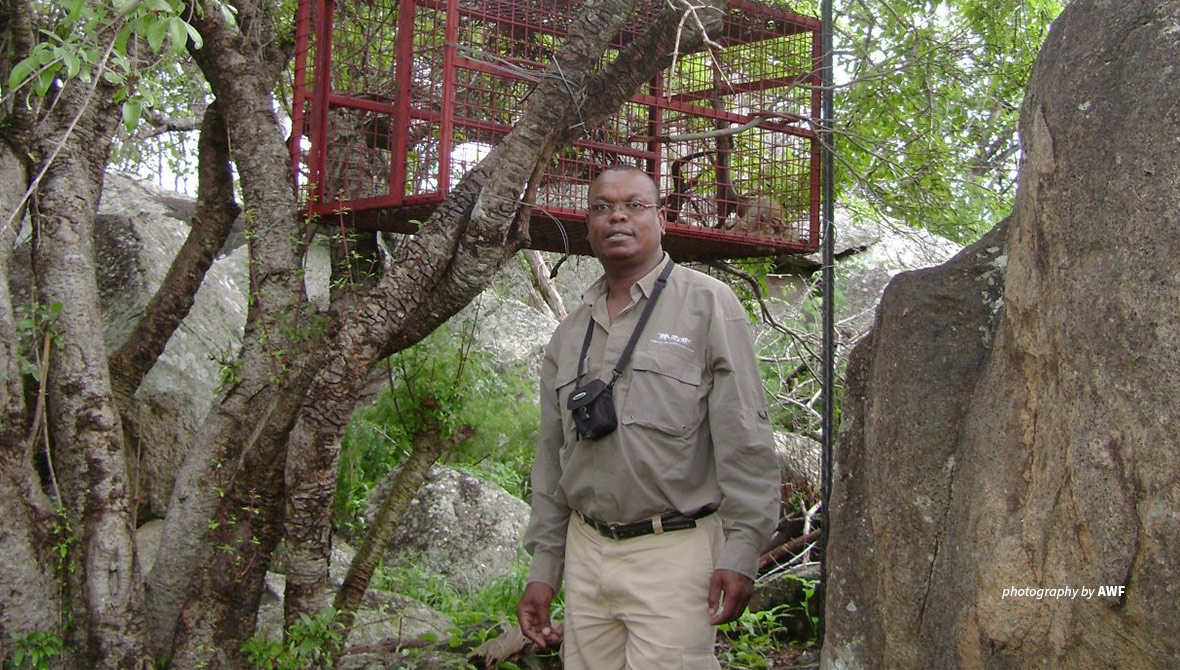A wildlife scientist embraces communication for conservation

AWF Vice President, Species Conservation and Science Philip Muruthi visiting a leopard conservation project site in the Limpopo Heartland in 2012
Sundowner Stories are a new blog series of first-hand stories going behind the scenes of AWF’s remarkable history. In the second installment, AWF Vice President, Species Conservation and Science Philip Muruthi reminisces about the birth of AWF’s large landscape conservation approach when he joined the organization 25 years ago and ponders the next frontier: how to tell stories that change how we see nature.
By the time I completed my Ph.D. in Ecology, Conservation & Evolutionary Biology, I had spent 10 years studying how baboon behavior, reproduction, development, and demography change depending on how close they are to human settlements. I returned to Kenya from Princeton University with a postdoc job offer at the Smithsonian Institution and a persisting desire to keep exploring whether the human impacts on wildlife were always good or bad.
And so, in February 1997, I decided to join African Wildlife Foundation (AWF) as the Project Officer of the Species and Ecosystems program, becoming Acting Coordinator five months later. Before then, I had known AWF as a relatively small organization building wildlife management capacity, mainly in East Africa. I took up the job at AWF because it was one of the first organizations of its kind to address conservation outside protected areas through partnership programs with governments and communities. It asked, ‘How can people benefit from wildlife?’ long before this question became a given for African conservation. And, sincerely, I liked that AWF was building the capacity of Africans to conserve wildlife at individual and institutional levels.
I could not have joined at a more seismic moment. AWF in 1997 was asking itself some critical questions, developing a new strategy, and reassessing the scale at which it should work across Africa. It was moving away from a purely thematic approach and seeking to conserve Africa’s biodiversity-rich areas to be both ecologically and socioeconomically functional. This large landscape approach is now given in conservation, but in 1997 it was radical and just emerging in Africa.
At the same time, AWF was moving away from protecting wildlife populations unimbedded in their natural landscapes and processes. In 1997, our species program comprised the Amboseli Elephant Research Project, the Mountain Gorilla Project in Rwanda, rhinos in Tsavo, Kenya and Namibia’s Waterberg Plateau, and cheetahs in Namibia. As we developed a new strategy, leadership challenged itself: Is this good enough? We crafted a new broader AWF approach to species conservation aligning with a new organizational strategy onto which we continue building today.
For a scientist fresh out of a Ph.D. program, I was very lucky to be involved in these critical debates and be part of conceptualizing AWF’s landscape approach, later named the African Heartlands Program. Over the next few years, we facilitated multiple stakeholders to develop visions for their landscapes in west, central, east and southern Africa. We also developed tools that enabled each landscape to strategically balance participatory land-use planning, conservation enterprise, and species and habitat conservation. We worked with governments, local authorities, and conservation partners to ensure the work was centered on a shared vision for the landscape. Additionally, AWF invested resources in implementing part of the landscape vision.
At the continental level, we identified 41 important conservation landscapes in sub-Saharan Africa. Elephants, rhinoceros, large carnivores, and great apes were selected as AWF priority species, later to be joined by giraffes. Our interventions to conserve wildlife populations adapted depending on the threats and challenges — and as the organization continues to evolve since then, I am reminded that the conservation of species is never really done; it is a constant.
For instance, when I joined AWF, I never thought one of the species I would be working with is dogs! But when the elephant and rhino poaching crisis flared between 2008 and 2012, AWF expanded its scope to tackle illegal wildlife trafficking by first developing our counter-wildlife trafficking approach, including deploying wildlife detection canines at transit points. We soon had to bring on legal and other professionals who could ensure the offenders are brought to book by upskilling prosecutorial, judicial, and law enforcement actors at local, national, and regional levels. To date, we have trained more than 4,500 in Africa.
In 1997, I was uncertain of the continued survival of the mountain gorilla. But now, their recovery gives me hope — despite the insecurity and civil conflict in their shared nations, the mountain gorilla is the only great ape species whose population is growing. When science connects with improving local livelihoods and sustainable economic growth, species recovery and ecosystem restoration are possible. There are many other successes in Africa.
In my time at AWF, I have found resilience to be essential — you must keep at it and rise to the occasion. I am a scientist and the head of species protection, but science is obviously not all; communication may as well be the next frontier in conservation. The solutions we need to conserve functional landscapes today are not science-based but about changing behavior. As such, the human aspect is still as central to my work as it is to conservation and the overall success of our world.